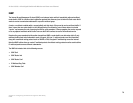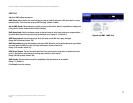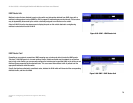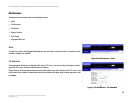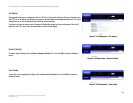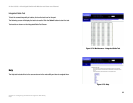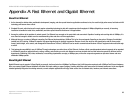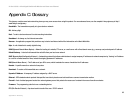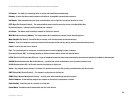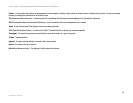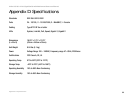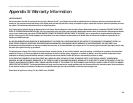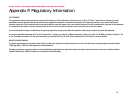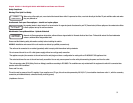
84
Appendix B: Cabling
Overview
24-Port 10/100 + 2-Port Gigabit Switch with Webview and Power over Ethernet
Appendix B: Cabling
Overview
Twisted Pair Cabling and Fiber Optic Cabling are discussed in this appendix.
Twisted Pair Cabling
There are different grades, or categories, of twisted-pair cabling. Category 5 is the most reliable and is highly recommended. Straight-through cables are used for connecting
computers to a hub. Crossover cables are used for connecting a hub to another hub (there is an exception: some hubs have a built-in uplink port that is crossed internally, which
allows you to link or connect hubs together with a straight-through cable instead).
You can buy pre-made Category 5 cabling, or cut and crimp your own. Category 5 cables can be purchased or crimped as either straight-through or crossover cables. A Category 5
cable has 8 thin, color-coded wires inside that run from one end of the cable to the other. All 8 wires are used. In a straight-through cable, wires 1, 2, 3, and 6 at one end of the
cable are also wires 1, 2, 3, and 6 at the other end. In a crossover cable, the order of the wires change from one end to the other: wire 1 becomes 3, and 2 becomes 6. See the
diagrams on this page for more detailed information on straight-through and crossover cabling.
To determine which wire is wire number 1, hold the cable so that the end of the plastic RJ-45 tip (the part that goes into a wall jack first) is facing away from you. Face the clip
down so that the copper side faces up (the springy clip will now be parallel to the floor). When looking down on the copper side, wire 1 will be on the far left.
Fiber Optic Cabling
Fiber optic cabling is made from flexible, optically efficient strands of glass and coated with a layer of rubber tubing, fiber optics use photons of light instead of electrons to send
and receive data. Although fiber is physically capable of carrying terabits of data per second, the signaling hardware currently on the market can handle no more than a few
gigabits of data per second.
Fiber cables come with two main types. The most commonly used fiber optic cable is multi-mode fiber cable (MMF), with a 62.5 micron fiber optic core. Single-mode fiber cabling
is somewhat more efficient than multi-mode but far more expensive, due to its smaller optic core that helps retain the intensity of traveling light signals. A fiber connection always
requires two fiber cables: one transmits data, and the other receives it.
Each fiber optic cable is tipped with a connector that fits into a fiber port on a network adapter, hub, or switch. In the U. S., most cables use a square SC connector that slides and
locks into place when plugged into a port or connected to another cable. In Europe, the round ST connector is more prevalent.
You must use the Linksys MGBT1, MGBSX1, or MGBLH1 miniGBIC modules with the Linksys SRW224P. The MGBSX1 and the MGBLH1 require fiber cabling with LC connectors. The
MGBT1 requires a Category 5 Ethernet Cable with an RJ-45 connector.



